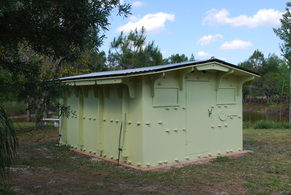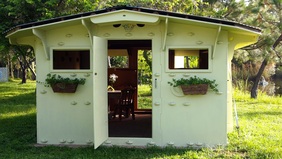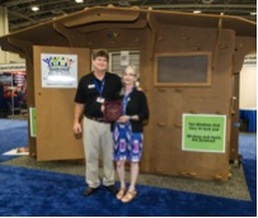
Could Shelter In A Day's disaster shelter change the world?
Part 2 of a 6 part series
Can a building be versatile enough to be useful for disaster relief, nation building, displaced populations, military personnel housing and storage, and backyard sheds without looking like a greenhouse, steel oven box, tent or yurt?
What would a better, cheaper, faster building look like? What should it do?
Here’s a wish list for immediate housing:
Would you believe this house exists! How was it done? What’s changed?
Part 2 of a 6 part series
Can a building be versatile enough to be useful for disaster relief, nation building, displaced populations, military personnel housing and storage, and backyard sheds without looking like a greenhouse, steel oven box, tent or yurt?
What would a better, cheaper, faster building look like? What should it do?
Here’s a wish list for immediate housing:
- Can be made quickly as needed and economically. There’s never enough resources.
- Stacks small and tall and forklifts to save cargo space. Delivers onsite with any standard truck.
- Is fast and simple to erect, without costly resources like power, heavy equipment or even tools.
- Can be built by anyone in hours, not days or weeks or even months. No training necessary.
- Can be built with or without a foundation. One may not be available and the need won’t wait.
- Is easily expandable and easily configurable for different needs.
- Can be secured to the ground with a simple to install, screw-into the ground, tie-down system.
- Uses long lasting, sustainable materials that are termite, rust and rot resistant.
- Provides immediate, lockable security for those in need, and their precious belongings.
- Offers real, permanent protection from the elements, not just shade.
- Comfortable in any climate with screened windows and cross ventilation.
- Is affordable not just initially, but over time. Saves most building costs.
- Can be easily modified with familiar tools to adapt to local needs.
- Can be disassembled, stored and reused when necessary.
- Damaged parts are easy to replace as all parts of the structure are standardized.
- Provides dignified, familiar looking, but most of all, affordable housing.
Would you believe this house exists! How was it done? What’s changed?
| Fiberboard is a man-made, wood sheet material, made from the world’s most basic sustainable resource, recycled wood fiber. It looks like a very thick sheet of waterproof brown paper, a bit like plywood without the plies, and it’s structurally very strong. It has been around for more than 30 years and there are many mills producing it worldwide but it has limited market visibility because it is hard to connect together. It doesn’t glue, screw or nail well, especially on the edges. This is why it’s not used more in the furniture industry. Chances are you have never really seen it in daily life. | |
I have been a cabinetmaker for over 45 years. My kitchen shop has a computerized (CNC) router, a relatively new technology that cuts all my cabinets, saving time, mistakes and money. With the collapse of the building industry in 2008, I found the time to take up my longstanding dream and began designing furniture to be cut with the CNC router. I was cutting fiberboard because it was the least expensive material I could get to practice with. Slowly, I came to respect this seldom used material.
To get around fiberboards’ connecting problem, I re-invented an old-style carpenter’s joint, the mortise and through-tenon with locking peg, making it possible to cut all the parts using a CNC router. This new Tool Free joint is designed to be assembled without metal fasteners, using just a hammer, cut from the same fiberboard material. The joint overcomes the connecting problems of the material and magnifies all its strengths. It forms a connection that has proven to be both easy to assemble and surprisingly strong, allowing the use of fiberboard for structural applications for the first time. These three leaps forward, (the ‘Green’ fiberboard material, the new joint, and precise cutting with a CNC router) working together, make Shelter In A Day a breakthrough development and an innovative, new technology.
According to World Population Balance website, our world population will add an average of 200,000 people every day. Additionally, millions, even billions of people now have unsafe, substandard housing made from found materials (that’s a nice word for junk). All these people need housing and this housing should be made from sustainable materials if we care about our future generations. Sustainable materials are used and reused and easily replaced, are natural in origin, are grown, not mined, and familiar to people
To get around fiberboards’ connecting problem, I re-invented an old-style carpenter’s joint, the mortise and through-tenon with locking peg, making it possible to cut all the parts using a CNC router. This new Tool Free joint is designed to be assembled without metal fasteners, using just a hammer, cut from the same fiberboard material. The joint overcomes the connecting problems of the material and magnifies all its strengths. It forms a connection that has proven to be both easy to assemble and surprisingly strong, allowing the use of fiberboard for structural applications for the first time. These three leaps forward, (the ‘Green’ fiberboard material, the new joint, and precise cutting with a CNC router) working together, make Shelter In A Day a breakthrough development and an innovative, new technology.
According to World Population Balance website, our world population will add an average of 200,000 people every day. Additionally, millions, even billions of people now have unsafe, substandard housing made from found materials (that’s a nice word for junk). All these people need housing and this housing should be made from sustainable materials if we care about our future generations. Sustainable materials are used and reused and easily replaced, are natural in origin, are grown, not mined, and familiar to people
In February, my Shelter won a People’s Choice Award at the Inventors Fair in Palm Beach. This spring, Shelter In A Day took the really big prize, Most Innovative Product, from the very people who really know the Disaster Relief World, in a landslide vote by this year’s participants at the Aid and International Development Forum in Washington, D.C.
Can I really build a house, school, clinic or church…in an afternoon?
Check back next week for Part 3. Read Part 1.
READERS: What are your thoughts?
Can I really build a house, school, clinic or church…in an afternoon?
Check back next week for Part 3. Read Part 1.
READERS: What are your thoughts?

About Shelter In A Day | Disaster Shelters
Winner of 2013 Aid and International Development Forum (AIDF) "Most Innovative Product Award." Shelter In A Day is the brainchild of eco-friendly, furniture designer Frank Schooley. Shelter's disaster recovery housing provides safe and secure, simple to construct, green homes for those displaced by natural disasters, such as hurricanes, earthquakes or floods.
The disaster shelters are a solidly constructed, termite, rust and rot resistant house, with lockable doors and windows. Homes are crafted from waterproof, recycled wood fiber material and can be easily erected anywhere, in one day.
Winner of 2013 Aid and International Development Forum (AIDF) "Most Innovative Product Award." Shelter In A Day is the brainchild of eco-friendly, furniture designer Frank Schooley. Shelter's disaster recovery housing provides safe and secure, simple to construct, green homes for those displaced by natural disasters, such as hurricanes, earthquakes or floods.
The disaster shelters are a solidly constructed, termite, rust and rot resistant house, with lockable doors and windows. Homes are crafted from waterproof, recycled wood fiber material and can be easily erected anywhere, in one day.
| | |


